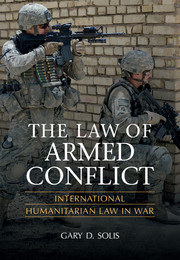Book contents
- Frontmatter
- Contents
- Table of Cases
- Table of Treaties
- Foreword
- Preface
- Acknowledgments
- LAW OF ARMED CONFLICT: INTERNATIONAL HUMANITARIAN LAW IN WAR
- 1 Rules of War, Laws of War
- 2 Codes, Conventions, Declarations, and Regulations
- 3 Two World Wars and Their Law of Armed Conflict Results
- 4 Protocols and Politics
- LAW OF ARMED CONFLICT AND INTERNATIONAL HUMANITARIAN LAW: A FRAMEWORK
- LAW OF ARMED CONFLICT AND INTERNATIONAL HUMANITARIAN LAW: BATTLEFIELD ISSUES
- References
- Index
- References
3 - Two World Wars and Their Law of Armed Conflict Results
from LAW OF ARMED CONFLICT: INTERNATIONAL HUMANITARIAN LAW IN WAR
- Frontmatter
- Contents
- Table of Cases
- Table of Treaties
- Foreword
- Preface
- Acknowledgments
- LAW OF ARMED CONFLICT: INTERNATIONAL HUMANITARIAN LAW IN WAR
- 1 Rules of War, Laws of War
- 2 Codes, Conventions, Declarations, and Regulations
- 3 Two World Wars and Their Law of Armed Conflict Results
- 4 Protocols and Politics
- LAW OF ARMED CONFLICT AND INTERNATIONAL HUMANITARIAN LAW: A FRAMEWORK
- LAW OF ARMED CONFLICT AND INTERNATIONAL HUMANITARIAN LAW: BATTLEFIELD ISSUES
- References
- Index
- References
Summary
Introduction
The 1863 Lieber Code and 1907 Hague Regulation IV are the foundations of much of today's law of war. In this chapter we examine the fruit of those initial efforts, the jus in bello, the battlefield law, that is in effect today, along with some of the efforts to give clearer definitions of Lieber and the Hague outcomes. What brought us from the 1863 Lieber Code to the 1949 Geneva Conventions? What are the Geneva Conventions and, in our study of law of armed conflict/international humanitarian law (LOAC/IHL), how should we navigate them?
The 1906 Geneva Convention
The passage of time brought calls for the revision of the first Geneva Convention for protection of the wounded. In 1868, several Articles were added to the 1864 Convention and, in 1906, thirty-five states, including the United States, met in Geneva, and a revised version of the 1864 Convention, now containing thirty-three Articles, was adopted.
The revised Convention, again addressing care of the wounded, added provisions for the transfer of information between the warring states regarding wounded prisoners. These informational provisions evolved into today's Central Prisoners of War Information Agency, and the Central Information Agency for protected persons. First envisioned by Hague Regulation IV, the two agencies collect information on prisoners of war (POWs) and protected persons and transmit it to their states of origin or residence, informing not only the state but the families, of the status and whereabouts of loved ones held by the opposing side.
- Type
- Chapter
- Information
- The Law of Armed ConflictInternational Humanitarian Law in War, pp. 73 - 118Publisher: Cambridge University PressPrint publication year: 2010



